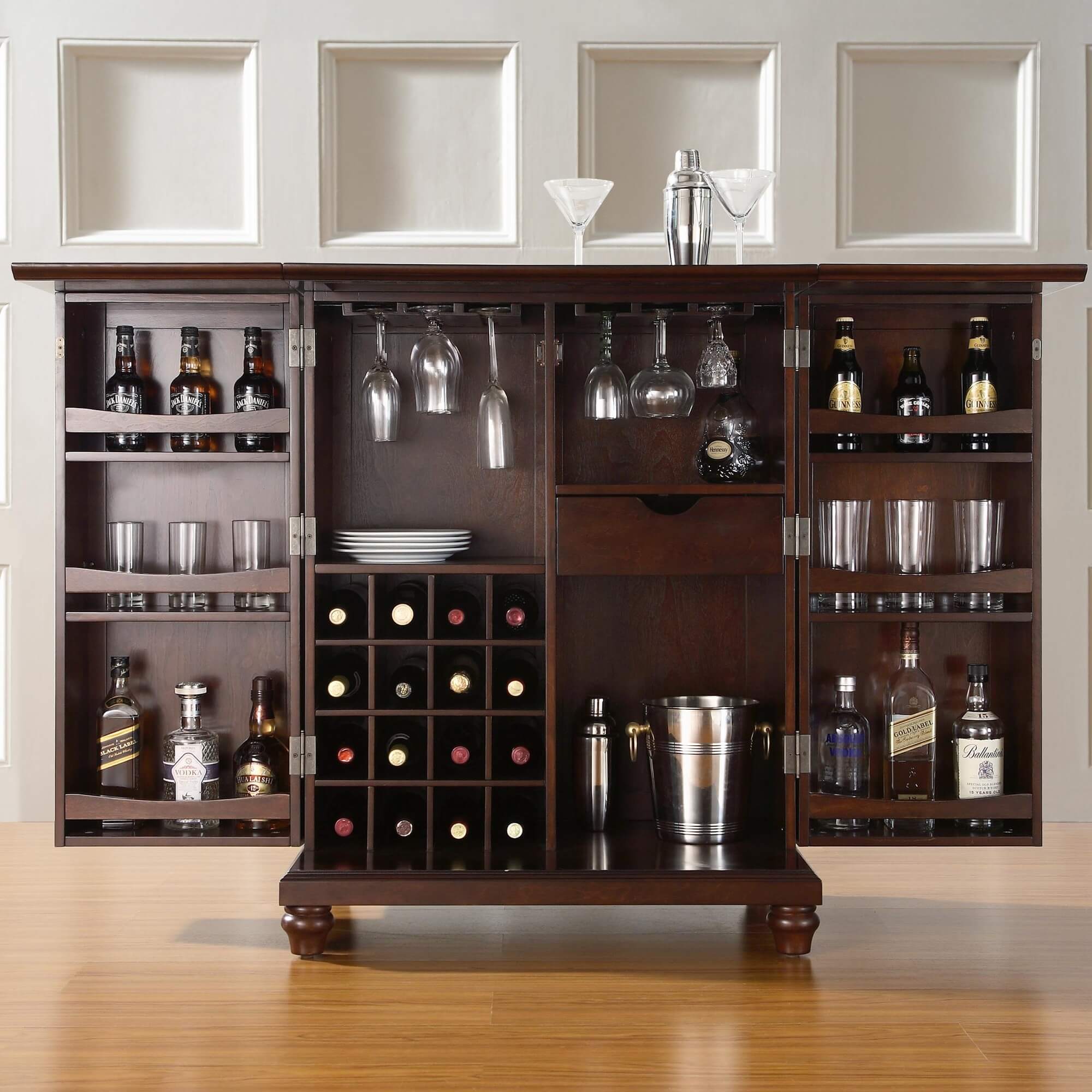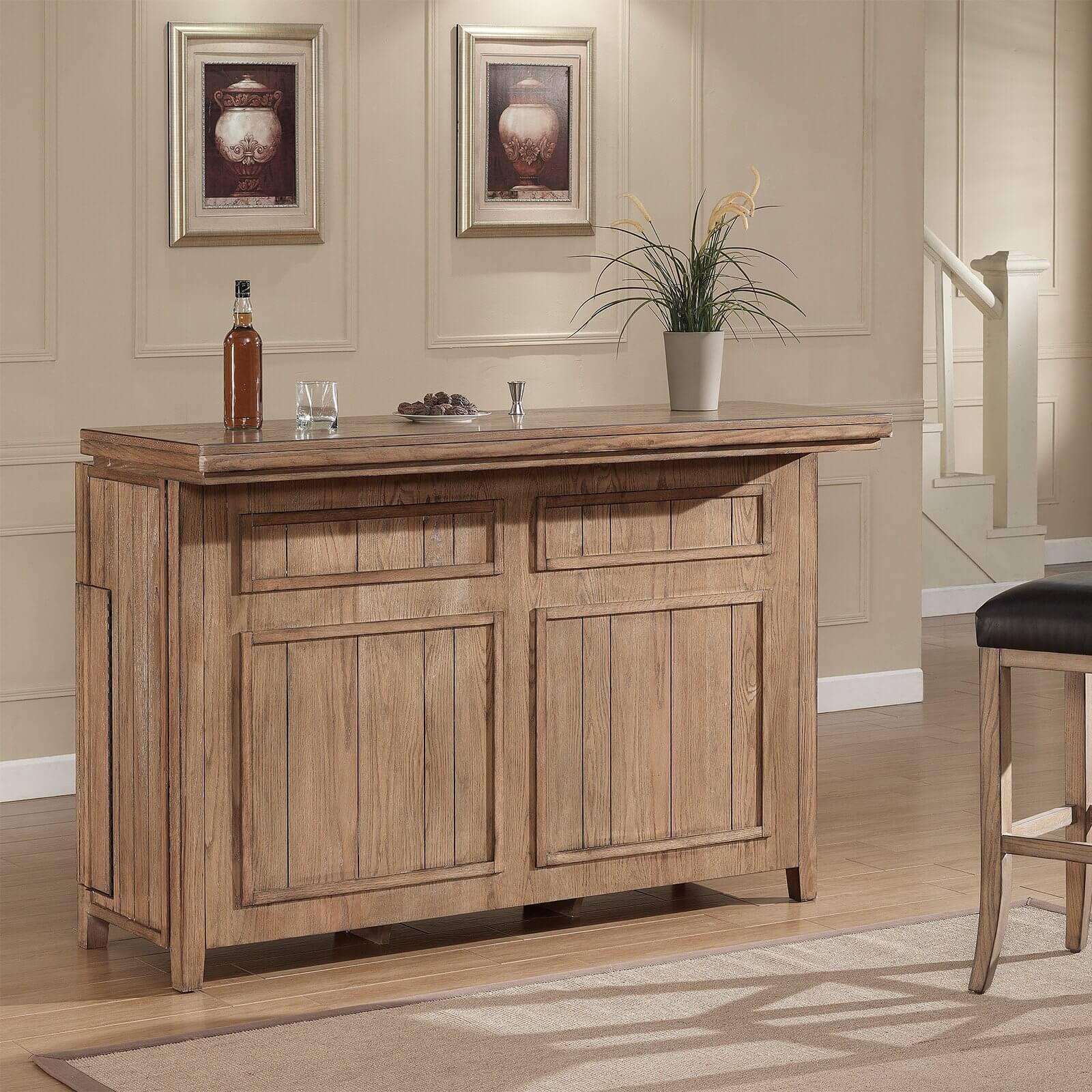Design & Features of Folding Home Bar Cabinets

Folding home bar cabinets offer a stylish and space-saving solution for enjoying beverages at home. Their ability to fold away neatly when not in use makes them ideal for apartments, smaller homes, or those who prefer a minimalist aesthetic. The design and features vary greatly, catering to a wide range of tastes and needs.
Design Styles and Materials
The style of a folding home bar cabinet can significantly impact its overall look and feel. Choosing the right style depends on your existing décor and personal preference. The following table summarizes some popular options:
| Style | Materials | Features | Price Range |
|---|---|---|---|
| Modern | High-gloss lacquered wood, metal, glass | Sleek lines, minimalist design, integrated lighting, hidden storage | $500 – $2000+ |
| Traditional | Solid wood (e.g., oak, cherry), veneers | Ornate detailing, classic shapes, multiple shelves, possibly a built-in mirror | $400 – $1500+ |
| Rustic | Reclaimed wood, metal accents, possibly leather | Distressed finishes, visible wood grain, open shelving, possibly a chalkboard surface | $300 – $1200+ |
| Contemporary | Combination of materials (wood, metal, plastic), clean lines | Multifunctional design, compact size, easy to fold and unfold | $300 – $1000+ |
Folding Mechanisms
Several mechanisms facilitate the folding action of these cabinets. The choice of mechanism influences both the cabinet’s functionality and its durability.
The most common mechanisms include:
- Hinged Panels: These cabinets utilize simple hinges to fold the cabinet’s sides or doors inward, creating a compact unit. Strengths include simplicity and affordability. Weaknesses include potential instability if not properly constructed and limited storage space.
- Accordion-Style: These cabinets use multiple panels that fold like an accordion. Strengths include maximizing storage space and allowing for a variety of configurations. Weaknesses include complexity in design and potential for wear and tear on the folding mechanism.
- Sliding Panels: These cabinets employ sliding panels that move along tracks to reveal the bar area. Strengths include smooth operation and a clean aesthetic. Weaknesses include the need for precise construction and potential for jamming.
Typical Features of Folding Home Bar Cabinets
Folding home bar cabinets often include a variety of features designed to enhance convenience and functionality. These features can vary based on the cabinet’s size, style, and price point.
The most common features are:
- Shelving for glasses and barware
- Bottle holders and racks for storing liquor bottles
- Wine racks for storing wine bottles
- Drawers for storing bar tools and accessories
- Integrated lighting to illuminate the bar area
- A countertop for preparing drinks
- Lockable storage compartments for securing valuable items
- Wheels for easy mobility
Visual Representation of a Folding Home Bar Cabinet
Imagine a contemporary folding home bar cabinet, approximately 48 inches wide, 18 inches deep, and 36 inches tall when fully extended. The cabinet is constructed from a combination of dark walnut-stained wood for the frame and sleek brushed stainless steel for the accents and hardware. The wood has a smooth, satin finish, while the stainless steel has a subtle brushed texture. The color palette is sophisticated and neutral, creating a sense of calm elegance. The cabinet features two hinged side panels that fold inward, revealing three adjustable shelves made of clear tempered glass, allowing the stored items to be visible. A built-in LED light strip under the top shelf subtly illuminates the glassware. A pull-out drawer below the shelves provides storage for bar tools. When folded, the cabinet measures approximately 18 inches wide, 18 inches deep, and 36 inches tall, making it easy to store against a wall or in a corner.
Materials & Construction of Folding Home Bar Cabinets

Choosing the right materials and construction methods is crucial for creating a durable and aesthetically pleasing folding home bar cabinet. The materials you select will significantly impact the cabinet’s longevity, appearance, and overall cost. This section explores common materials, provides a simple construction guide, and addresses potential challenges.
Common Materials and Their Properties
The selection of materials for a folding home bar cabinet depends largely on budget, desired aesthetic, and the level of durability required. Several options exist, each with its own set of advantages and disadvantages.
| Material | Pros | Cons | Suitable Styles |
|---|---|---|---|
| Solid Wood (e.g., Oak, Mahogany, Pine) | Durable, aesthetically pleasing, can be stained or painted, adds warmth and character. | Expensive, requires regular maintenance (e.g., sealing, polishing), susceptible to warping or cracking if not properly treated. | Traditional, rustic, modern farmhouse |
| Medium-Density Fiberboard (MDF) | Cost-effective, smooth surface ideal for painting or veneering, readily available. | Not as durable as wood, can be easily damaged, edges can chip, not suitable for outdoor use. | Modern, minimalist |
| Metal (e.g., Steel, Aluminum) | Durable, resistant to damage, easy to clean, can be powder-coated for various finishes. | Can be expensive, susceptible to rust (unless treated), can be heavy and difficult to move. | Industrial, contemporary |
| Composite Materials (e.g., Laminate) | Cost-effective, easy to clean, wide variety of colors and patterns available. | Less durable than wood or metal, can be easily scratched or damaged, may not be as aesthetically pleasing as natural materials. | Modern, contemporary |
Building a Simple Folding Home Bar Cabinet
This guide Artikels the construction of a basic folding cabinet using readily available materials like MDF and simple hinges. More complex designs would require additional tools and skills.
Folding home bar cabinet – Materials: MDF sheets (for sides, top, bottom, shelves), hinges (heavy-duty), screws, wood glue, wood filler, sandpaper, paint or stain (optional), protective sealant (optional).
Tools: Measuring tape, saw (circular saw or jigsaw), drill, screwdriver, clamps, sanding block, paintbrushes (if painting).
- Cut the MDF: Measure and cut the MDF sheets according to your desired dimensions. Accurate measurements are critical for proper fit and function.
- Assemble the Cabinet Sides: Use wood glue and screws to join the sides of the cabinet, ensuring square corners. Clamps will help maintain alignment during drying.
- Attach Hinges: Carefully attach heavy-duty hinges to the sides of the cabinet, ensuring they are properly aligned for smooth folding action. Pre-drilling pilot holes is recommended to prevent splitting the wood.
- Add Shelves (optional): If desired, add shelves using additional MDF and supports.
- Fill and Sand: Fill any gaps or imperfections with wood filler, allow to dry, and sand smooth for a professional finish.
- Finish: Apply paint, stain, or a sealant to protect the cabinet and enhance its appearance.
Challenges and Solutions in Construction
One of the main challenges in building a folding home bar cabinet lies in the hinge mechanisms and ensuring structural integrity. Inadequate hinges can lead to sagging or uneven folding, while poor construction can compromise the cabinet’s stability.
Hinge Mechanisms: Using heavy-duty hinges designed for the weight of the cabinet is crucial. Proper alignment during installation is essential for smooth operation. Consider using multiple hinges for larger cabinets to distribute the weight and prevent stress on individual hinges.
Structural Integrity: Use appropriate joinery techniques (like dadoes or rabbets) for strong connections between cabinet parts. Reinforce corners with corner brackets for extra support. Consider using thicker MDF for added strength, especially for larger cabinets.
Placement & Integration of Folding Home Bar Cabinets

Choosing the right location for your folding home bar cabinet is crucial for both its functionality and aesthetic integration within your home. Careful consideration of the room’s design, traffic flow, and your personal entertaining style will ensure a seamless and enjoyable addition to your living space. This section explores optimal placement strategies and design ideas for various rooms, along with tips for enhancing the cabinet’s visual appeal.
Folding Bar Cabinets in Living Rooms
The living room, often the heart of the home, presents a unique opportunity to integrate a folding bar cabinet subtly and stylishly. Its placement should complement the existing décor and flow of the room, while remaining easily accessible for entertaining.
Consider placing the cabinet against a less prominent wall, perhaps flanking a fireplace or nestled within a built-in unit to create a cohesive look. Avoid placing it directly in high-traffic areas to prevent accidental bumps and spills. A well-lit alcove can also showcase the cabinet beautifully.
A minimalist living room might benefit from a sleek, modern folding bar cabinet, while a more traditional space might suit a cabinet with richer wood tones and ornate details. The cabinet’s color and material should complement the existing furniture and wall colors.
Folding Bar Cabinets in Kitchens
Integrating a folding bar cabinet into a kitchen can enhance functionality and style. The key is to find a location that maximizes convenience without cluttering the workspace.
If space allows, a dedicated bar area within the kitchen, perhaps near a counter or island, is ideal. Alternatively, a less obtrusive location like a pantry or an unused corner can work well, provided it’s still easily accessible. Consider the cabinet’s size and ensure it doesn’t impede kitchen traffic flow.
For a smaller kitchen, a compact folding bar cabinet with a sleek design can be a space-saving solution. A larger kitchen can accommodate a more elaborate cabinet, perhaps incorporating additional storage for glassware or bar accessories.
Folding Bar Cabinets in Dining Rooms
A folding bar cabinet in the dining room offers convenient access to drinks and barware during meals and gatherings. Strategic placement is key to enhancing both the room’s functionality and its aesthetic appeal.
Position the cabinet near the dining table but not so close as to obstruct the seating area or walkways. A sideboard or a designated buffet area is a natural fit for a folding bar cabinet. Ensure the cabinet’s style complements the dining table and overall room décor.
A cabinet with a stylish top can also double as a serving area, enhancing its versatility. In a formal dining room, a more elegant and ornate cabinet would be appropriate, whereas a casual dining area might suit a simpler, more rustic design.
Advantages and Disadvantages of Different Placement Locations, Folding home bar cabinet
The choice of location for your folding home bar cabinet significantly impacts its utility and aesthetic contribution.
| Location | Advantages | Disadvantages |
|---|---|---|
| Living Room | Central location for entertaining, readily accessible, enhances ambiance. | May occupy valuable floor space, potential for spills and damage in high-traffic areas. |
| Kitchen | Convenient access to drinks and barware during meal preparation, integrates with cooking area. | May clutter workspace if improperly placed, potential for damage from kitchen spills and heat. |
| Dining Room | Convenient access during meals and gatherings, enhances dining experience. | May obstruct seating or traffic flow if not strategically placed. |
Enhancing the Aesthetic Appeal with Lighting and Decorative Elements
Proper lighting and decorative elements can significantly elevate the visual appeal of your folding bar cabinet.
Incorporate subtle lighting, such as LED strip lights inside the cabinet or under-cabinet lighting, to highlight the barware and create a warm ambiance. Consider adding decorative elements like patterned backsplashes, textured surfaces, or even a small mirror to reflect light and expand the visual space.
The cabinet’s overall style should be considered when selecting decorative elements. A modern cabinet might benefit from minimalist lighting and sleek metallic accents, while a more traditional cabinet could incorporate warmer lighting and ornate hardware. Adding plants or other decorative objects atop the cabinet can also add personality and visual interest.
